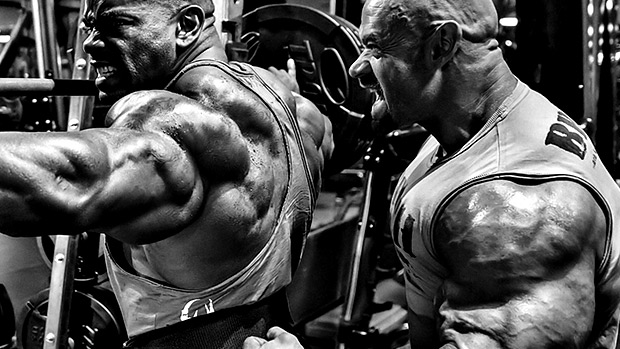When we were young lifters, searching for answers usually meant imitating the workouts of the biggest guy in the gym or flipping to page 36 of a magazine to see our favorite bodybuilder's nutrition suggestions.
Our naïve minds soaked up rivers of bro-science without even knowing it. To us, it was just learning from the most muscular dudes. I mean, if he's got traps on top of his traps, he must know what he's talking about, right?
Unfortunately, research has showed us that many bro-science recommendations were just flat-out wrong. But those steroid-taking competitors also had some great advice. The early bodybuilding community was spot on about a lot of things well before research could confirm them.
1. Training Volume
Personal trainers love bashing bodybuilders who do high volume workouts with lots of drop sets. They claim volume is for enhanced lifters whereas natural lifters should minimize volume because of excess cortisol and muscle damage.
There's some truth to this, but maximizing hypertrophy usually means doing more volume, not less, even in natural lifters. Consider the studies that show as much as 45 weekly sets per muscle group resulted in no muscle loss (1).
In fact, the research is consistent on this point: More volume is generally better. A 2017 systematic review and meta-analysis done by T Nation contributor Brad Schoenfeld looked at 15 studies that showed volume has a dose response (2).
This means the more weekly sets you do, the more muscle you build. Now, this doesn't mean you should train with high volume indefinitely. It just means given a period of time, you'll likely benefit from increasing volume – assuming you can recover from it.
Gradually increase your volume and push the limits within certain weeks of your program while mixing in weeks of lower-volume training or deloading to manage fatigue. But always limiting volume is never the answer.
Bodybuilders knew it all along: Volume drives hypertrophy.
2. The Mind-Muscle Connection
Some people teased Arnold for how intently he focused on his muscles while lifting. As long as you move the weight through the same range of motion, the hypertrophy is the same, regardless of what you're thinking about, right?
Not quite. The mind-muscle connection is a real thing. Focusing passionately on squeezing your muscles as they contract does produce more hypertrophy (3). You might look like a meathead who's in love with your biceps, but at least your curls will generate more growth.
The mind-muscle connection isn't bro-science – it's actual science.
3. Regional Hypertrophy
Regional hypertrophy is the idea that you can grow regions of the same muscle more than others. For example, a bodybuilder might try a certain preacher curl variation with a very specific grip to bring up his lower biceps.
This is one of those things that even the most gullible person would instantly say sounds like complete bro-science. Even kinesiology students will often annoyingly quote how their outdated textbooks clearly show that muscles contract as a whole, so regional hypertrophy is a myth.
Well, the controlled research shows those old school bros were spot on all along. We now know regional hypertrophy is possible. This is why certain exercises that place tension near a certain joint might slightly favor hypertrophy in that region (5,6,7).
If you're a kinesiology student, don't be arrogant. Meatheads can be pretty smart too, and competitors wouldn't be doing it if it wasn't working.
4. Animal Protein
To get protein, meatheads eat beef, chicken, or anything with a face. When they drink a protein shake, it's casein or whey. Not soy. Not peas. And not whatever the latest hipster plant-based protein is.
There's nothing fancy about animal protein. It's common and basic, but guess what? It works better than plant-based protein. Animal protein is far more likely to have a complete amino acid profile, which is dearly important for building new muscle. Animal protein also tends to have more leucine, which is pivotal to the muscle-building process (9).
If you subsist on incomplete protein sources such as beans and rice, that means you have to eat combinations of them throughout the day to even get a shot at getting the same muscle building effects as meat. And even then, the results are likely still not as substantial.
Soy is one of the few non-animal proteins that has a complete amino acid profile and it's also considered a fast protein, just like whey, but sadly, soy protein leads to inferior gains (10).
So if you want to use plant-based protein, you're going to have to mix and match between specific sources to ensure a full amino acid profile. Or you can get a better effect simply by listening to the meatheads with veiny biceps. Drink casein or whey and eat animal flesh.

1. Training Frequency
Body-part splits exploded during the steroid era and unsurprisingly, many bros still do them today. Body part splits usually resemble something like this:
- Monday: Chest
- Tuesday: Back
- Wednesday: Shoulders
- Thursday: Legs
- Friday: Arms
Now, there's nothing wrong with body part splits. They obviously work, but they only train muscle groups once per week. The rationale was that you needed to slaughter a muscle in one day and then give it a whole week to recover.
But training muscles more often is better. In individual studies, when volume is matched, the higher frequency group usually ends up with more muscle. Higher frequency training also allows you to achieve more weekly volume while minimizing fatigue because the volume per body part each workout would be lower than a body-part bro split.
Training splits like full body, push/pull, or upper/lower work much better than the bro splits still being done by all those close-minded meatheads.
2. Rest Periods
A lot of bros loved high volume workouts with short breaks. The idea was to accumulate fatigue, get a satisfying pump, and maximize metabolic stress.
This bro theory doesn't hold up too well, though. Recent studies show longer rest periods tend to promote greater increases in both strength and hypertrophy when volume is matched (4). There's a time and place for getting a metabolically charged pump, but a majority of your workouts should involve adequate rest times between sets.
This allows you to perform better, use more optimal loads, and create more mechanical tension because you're less fatigued. When in doubt, err on the side of resting longer between sets, not shorter.
3. Fasted Cardio
It's not that it's necessarily bad, but many physique competitors often tout it as something that causes more fat loss.
It's true that you're more likely to use fat as a fuel source when fasted, but when daily calorie intake is accounted for, it doesn't matter how you do your cardio – the end result is the same given the same total food intake (8).
You're not losing more fat just because you jog on an empty stomach. Thermodynamics still dictates net fat loss, so don't worry about conventional cardio advice. Do it fed or fasted, but if you want to lose weight, the real battle's at the dinner table, not the treadmill.
4. Meal Frequency
We all know bros who still eat six small meals a day, bringing their Tupperware with them everywhere they go. This stems from the theory that eating frequently spikes your metabolism. Well, this is a myth that's been debunked. The metabolism boost from eating depends on the total caloric intake and macronutrient ratios, not the frequency.
Studies show when caloric intake is equal, the amount of meals you eat doesn't matter – metabolism and fat loss is the same (11).
The average bodybuilder today knows this, but it seems the average gym goer still believes this six-meal nonsense, thanks to all the unscientific Instagram gurus.
- Schoenfeld BJ et al. Resistance Training Volume Enhances Muscle Hypertrophy but Not Strength in Trained Men. Med Sci Sports Exerc. 2019 Jan;51(1):94–103. PMC.
- Schoenfeld BJ et al. Dose-Response Relationship between Weekly Resistance Training Volume and Increases in Muscle Mass: A Systematic Review and Meta-Analysis. J Sports Sci. 2017 Jun;35(11):1073-1082. PubMed.
- Schoenfeld BJ et al. Differential Effects of Attentional Focus Strategies during Long-Term Resistance Training. Eur J Sport Sci. 2018 Jun;18(5):705-712. PubMed.
- Schoenfeld BJ et al. Longer Interset Rest Periods Enhance Muscle Strength and Hypertrophy in Resistance-Trained Men. J Strength Cond Res. 2016 Jul;30(7):1805-12. PubMed.
- Mendiguchia J et al. Nonuniform Changes in MRI Measurements of the Thigh Muscles after Two Hamstring Strengthening Exercises. J Strength Cond Res. 2013 Mar;27(3):574-81. PubMed.
- Wakahara T et al. Nonuniform Muscle Hypertrophy: Its Relation to Muscle Activation in Training Session. Med Sci Sports Exerc. 2013 Nov;45(11):2158-65. PubMed.
- Schoenfeld BJ et al. Regional Differences in Muscle Activation during Hamstrings Exercise. J Strength Cond Res. 2015 Jan;29(1):159-64. PubMed.
- Schoenfeld BJ et al. Body Composition Changes Associated with Fasted versus Non-Fasted Aerobic Exercise. J Int Soc Sports Nutr. 2014 Nov 18;11(1):54. PubMed.
- van Vliet S et al. The Skeletal Muscle Anabolic Response to Plant- versus Animal-Based Protein Consumption. J Nutr. 2015 Sep;145(9):1981-91. PubMed.
- Tang JE et al. Ingestion of Whey Hydrolysate, Casein, or Soy Protein Isolate: Effects on Mixed Muscle Protein Synthesis at Rest and Following Resistance Exercise in Young Men. J Appl Physiol (1985). 2009 Sep;107(3):987-92. PubMed.
- Cameron JD et al. Increased Meal Frequency Does Not Promote Greater Weight Loss in Subjects Who Were Prescribed an 8-Week Equi-Energetic Energy-Restricted Diet. Br J Nutr. 2010 Apr;103(8):1098-101. PubMed.




